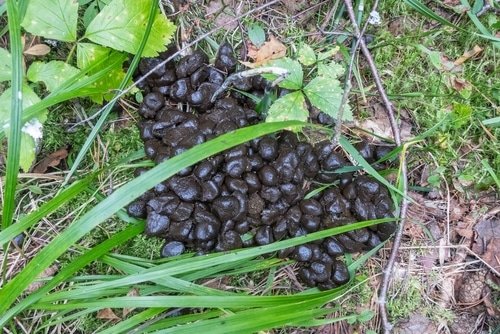Welcome to the delightful world of moose steak recipes, fellow food enthusiasts! In this article, we embark on a culinary journey that showcases the magnificence of this majestic creature’s meat.
Moose steak has long been savored by those who appreciate the bountiful offerings of nature’s larder. But before we dive into the compelling details of cooking moose steaks, let us take a moment to explore its fascinating history and understand the unique characteristics that make it a star ingredient in many delicious steak dishes.
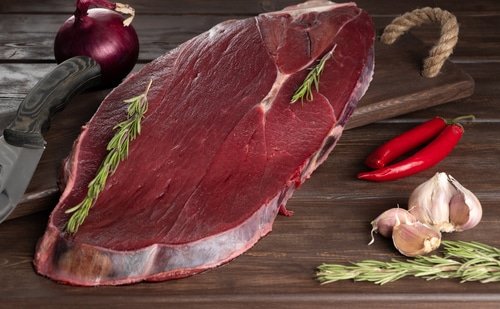
Moose Meat Flavor and Texture
Moose meat stands apart from other game meats due to its distinct flavor profile and remarkable texture. The taste is rich and earthy, with subtle hints of sweetness that add depth to each bite. Its velvety texture is both tender and dense at the same time – a culinary paradox that keeps us coming back for more.
The natural diet of moose contributes significantly to its unique flavor profile. These majestic creatures graze on various plants, such as grasses, aquatic vegetation, and shrubs, lending their meat a subtle hint of the diverse flora surrounding them.
Additionally, their relatively low-fat content compared to other red meats allows the flavors to shine through without overpowering the palate. When cooked correctly, moose steak rewards us with a melt-in-your-mouth experience that is simultaneously succulent and satisfying.
Its tenderness seems almost paradoxical considering the animal’s enormous size. Yet, we can savor a truly remarkable gastronomic indulgence by employing techniques that unlock its potential and enhance its inherent qualities.
Preparing Moose Steaks
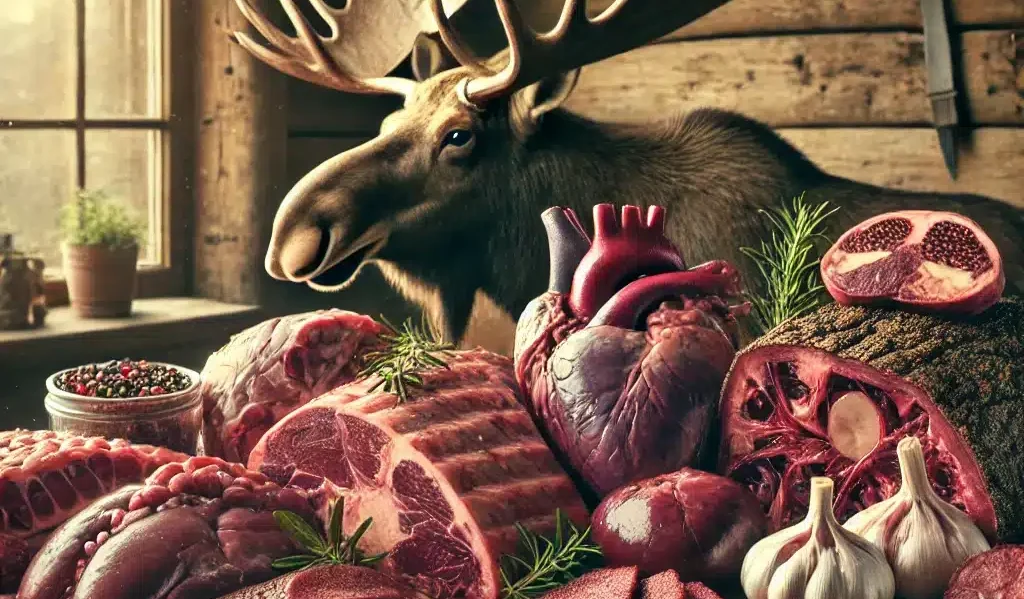
Selecting the Right Cut of Moose
When cooking moose steaks, selecting the right cut of meat is crucial. You want a cut that is tender and full of flavor. The best cuts for steaks are usually from the backstrap or tenderloin, which are lean and extremely tender.
These cuts are located along the spine of the moose and offer a melt-in-your-mouth experience when cooked properly. Opting for these cuts ensures that your efforts in creating delicious steak dishes will be well rewarded.
Proper Marinating Techniques for Enhancing Flavor
Moose meat has a unique taste that can be further elevated through marination. Marinating adds flavor and helps tenderize the meat, making it more succulent.
To marinate moose steaks, you’ll need a mixture of acidic ingredients like vinegar or citrus juice and various herbs, spices, and oils to enhance the taste profile. The acidic nature of marinades helps break down the connective tissues in the meat and allows flavors to penetrate deeply.
Popular Marinade Recipes for Moose Steaks
Several popular marinade recipes pair perfectly with moose steaks. One classic option combines soy sauce, Worcestershire sauce, garlic powder, onion powder, and black pepper.
This marinade infuses the meat with umami-rich flavors while adding depth to its taste profile. Another mouthwatering recipe involves mixing balsamic vinegar, Dijon mustard, honey, minced garlic cloves, thyme leaves, and olive oil – resulting in a tangy yet sweet combination that complements moose steak beautifully.
Importance of Marinating Time and Temperature
When marinating moose steaks, time and temperature play crucial roles. The marinating time depends on the thickness of the steaks; generally, a minimum of 4 to 6 hours is recommended, but you can go up to overnight for a more intense flavor. Marinating the steaks in a sealed container or zip-lock bag in the refrigerator is important, preventing bacterial growth.
Additionally, allowing the meat to return to room temperature before cooking helps it cook more evenly and enhances its tenderness. By carefully selecting cuts, employing proper marinating techniques with delicious recipes, and paying attention to marinating time and temperature, you’ll be well on your way to preparing delectable moose steaks that will impress your guests with their exceptional flavor and tenderness.
Cooking Techniques for Moose Steaks
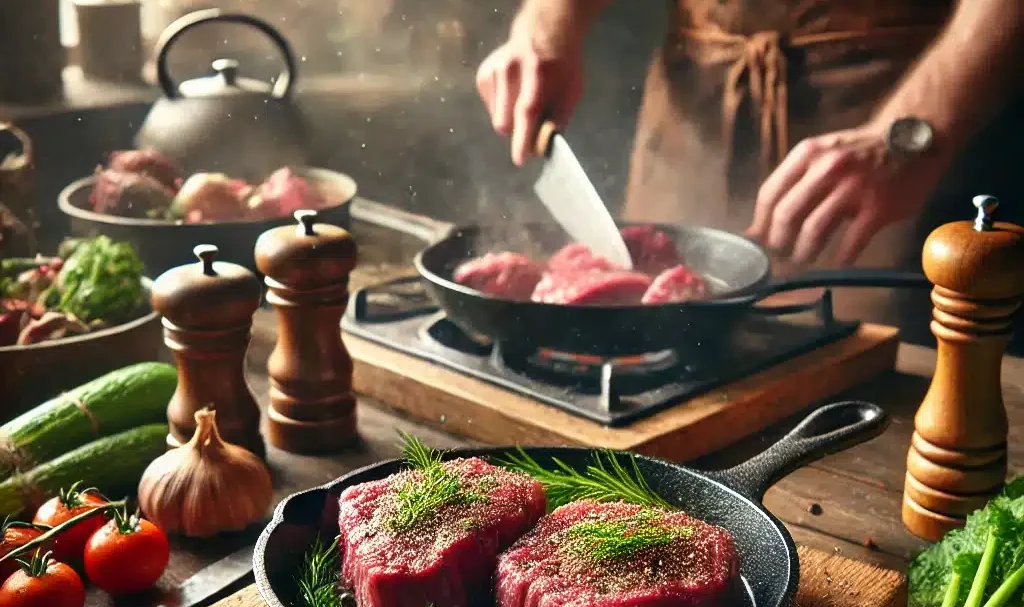
Grilling Moose Steaks to Perfection
Grilling is a popular choice for many meat enthusiasts when cooking moose steaks. To achieve a juicy and tender result on the grill, follow these key tips. First and foremost, make sure you select the right thickness of the steak.
Thinner cuts are more prone to drying out, so opt for steaks at least 1 inch thick. Secondly, marinating the steaks before grilling is essential.
This not only enhances the flavor but also helps to tenderize the meat. Experiment with different marinades, such as soy sauce, garlic, Worcestershire sauce, olive oil, rosemary, and balsamic vinegar.
When it comes to grilling times for moose steaks, it is crucial to consider both the thickness of the steak and your desired level of doneness. For rare steaks about 1 inch thick, grill each side for approximately 3-4 minutes.
Increase the grilling time by a minute on each side for medium-rare doneness. If you prefer your steak closer to medium or well-done (though this may risk compromising tenderness), add another minute or two per side accordingly.
Pan-Searing Moose Steaks for a Flavorful Crust
If you’re looking for an alternative cooking method that still delivers incredible taste, pan-searing your moose steaks can create a delicious crust while sealing in all those savory juices. To start pan-searing, choose a heavy-bottomed skillet or cast-iron pan that can retain heat evenly throughout cooking.
Before placing your moose steak in the pan, ensure it’s at room temperature and properly seasoned. Select a high-smoke-point oil, such as canola or vegetable oil, for searing.
Heat the pan over medium-high heat until it’s hot but not smoking. Gently lay the seasoned steak into the pan and let it sizzle for a few minutes without moving it.
This initial sear helps develop that coveted crust. To achieve a delicious sear on both sides of your moose steak, flip it using tongs or a spatula only once during cooking.
Allow each side to cook for 3-4 minutes for medium-rare doneness, or adjust the time based on your preferred level. Following these straightforward instructions will reward you with mouthwatering moose steaks that are grilled to perfection or boast an enticing crust from pan-searing.
Serving Suggestions and Accompaniments
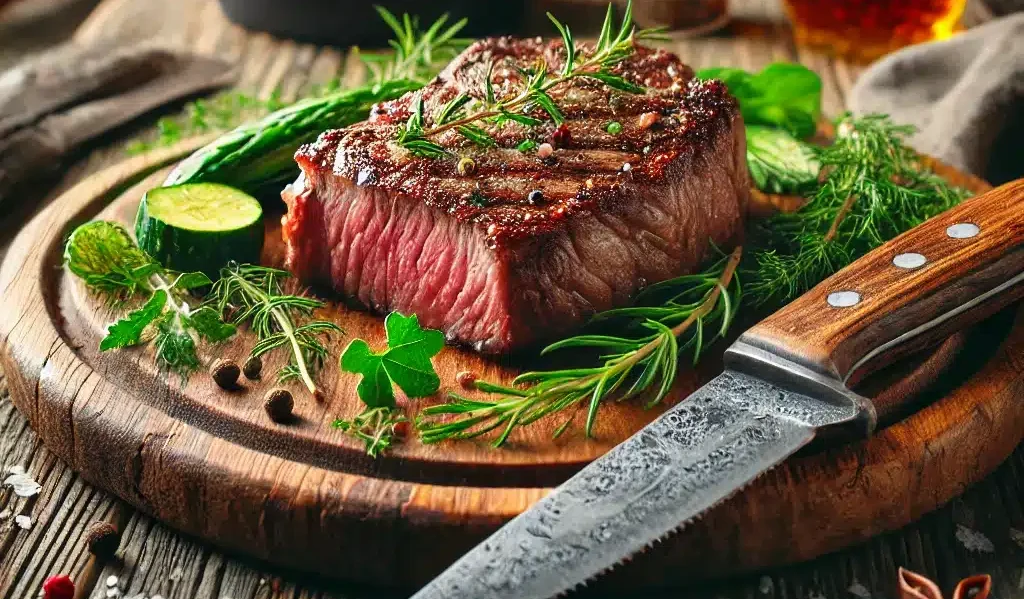
Pairing flavors with moose steaks
When serving delicious steak dishes made from moose, finding the right flavors to complement the rich meat is key. Classic seasoning combinations, such as a simple blend of salt, pepper, and garlic powder, can elevate the taste of moose steaks. The meat’s earthy and slightly gamey flavor pairs well with these traditional seasonings, enhancing its natural taste without overpowering it.
Exploring adventurous flavor profiles with unique spice blends
For those who want to explore bolder flavors when cooking moose steaks, venturing into unique spice blends can be a thrilling culinary adventure. Consider trying an aromatic mix of smoked paprika, cumin, and coriander for a smoky undertone that adds depth to each bite. Alternatively, a combination of chili powder, cocoa powder, and cinnamon creates an intriguing sweet-spicy profile that complements the richness of the meat in an unexpected way.
Side dishes that enhance the overall meal experience
Choosing side dishes that harmonize with the flavors is crucial to creating a complete dining experience with your moose steak dish. Traditional sides like roasted vegetables are always safe since they add texture and vibrant colors to your plate while providing a balanced taste.
Mashed potatoes are another classic option that pairs beautifully with moose steaks – their creamy consistency provides a comforting contrast to the robustness of the meat. For those seeking more adventurous options, consider serving wild rice pilaf alongside your steak for its nutty flavor, or try cranberry chutney for a tangy-sweet accompaniment that cuts through the richness.
When it comes to serving up delectable moose steak recipes, considering pairing ideas and thoughtful side dishes will take your meal to the next level. Whether you opt for classic seasoning combinations that complement the meat’s richness or venture into adventurous flavor profiles with unique spice blends, the key is to enhance and celebrate the natural flavors of this exquisite game meat.
And don’t forget to choose side dishes that enhance the overall experience, whether you go for traditional sides like roasted vegetables and mashed potatoes or get creative with wild rice pilaf or cranberry chutney. Enjoy!
Nutritional Benefits of Consuming Moose Meat

Moose meat offers various benefits, making it a favorable choice for health-conscious individuals. One notable advantage is its high protein content, surpassing other meats like beef or chicken. This makes moose meat an excellent option for those looking to build muscle or maintain a balanced diet.
Additionally, what sets moose meat apart is its low-fat levels compared to other red meats. This means you can savor the flavors and tenderness of a juicy moose steak without worrying about excessive saturated fats.
Moose meat also boasts a variety of essential vitamins and minerals necessary for optimal health. It is particularly rich in B vitamins such as niacin, riboflavin, and vitamin B12, which play crucial roles in energy production and brain function.
Furthermore, moose meat contains minerals like iron, zinc, and selenium, which support immune systems and promote overall well-being. Notably, moose meat is also a great source of omega-3 fatty acids, an essential nutrient known for its potential heart-protective effects.
Sustainable Hunting Practices
Consuming moose meat provides nutritional benefits and raises awareness about sustainable hunting practices. In many regions where moose populations exist, strict regulations ensure the responsible management of these majestic animals.
By adhering to established hunting seasons, bag limits, and licensing requirements set by wildlife agencies or conservation programs, hunters contribute to preserving these species for future generations. Sustainable hunting practices help balance wildlife conservation and meet human needs for food sources from nature’s bounty.
These regulations are designed with ecological considerations, considering population size dynamics and habitat conservation. By participating in the regulated hunting of moose, communities can enjoy the benefits of locally sourced, organic, and sustainable meat while contributing to ecosystems’ overall stability and harmony.
Conclusion
Moose meat is a delectable choice for cooking delicious steak dishes and offers numerous health benefits. With its high protein content and low-fat levels compared to other meats, moose meat provides a nutritious option for individuals seeking to maintain a balanced diet. Additionally, it is rich in essential vitamins, minerals, and omega-3 fatty acids that support overall well-being.
By engaging in sustainable hunting practices and abiding by moose hunting regulations, we can enjoy the flavorsome experience of indulging in moose steaks while contributing to conservation efforts to preserve these magnificent creatures. Embracing nature’s offerings responsibly brings us closer to a harmonious coexistence with our environment while savoring every bite with satisfaction.



